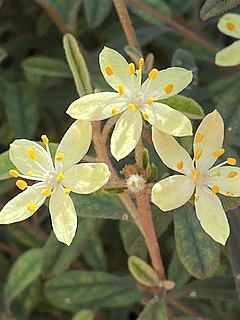
Asterolasia asteriscophora, commonly known as lemon starbush, is a species of slender, erect shrub in the family Rutaceae and is endemic to southern continental Australia. It has woolly, star-shaped hairs on its young branches, variably-shaped leaves covered with brownish or whitish hairs on the underside, and yellow flowers with woolly brown, star-shaped hairs on the back.
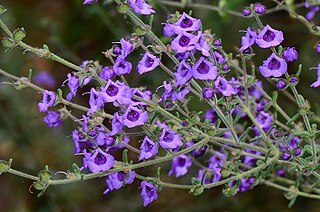
Prostanthera hirtula, commonly known as hairy mintbush, is a species of flowering plant in the family Lamiaceae and is endemic to the south-eastern continental Australia. It is a strongly aromatic, densely hairy, spreading shrub with narrow egg-shaped leaves and dark mauve flowers, and that grows in exposed, rocky sites.

Isopogon buxifolius is a species of plant in the family Proteaceae and is endemic to the south-west of Western Australia. It is an upright shrub with egg-shaped to elliptic or oblong leaves and clustered spikes of pink flowers.
Leptospermum sericeum, commonly known as the silver tea tree, is a species of shrub that is endemic to the south-west of Western Australia. It has thin, firm bark, egg-shaped leaves with the narrower end towards the base, relatively large, pink flowers and fruit that fall from the plant with the seeds. It grows in windswept rock crevices near Esperance.

Boronia capitata, commonly known as the cluster boronia, is a plant in the citrus family, Rutaceae and is endemic to the south-west of Western Australia. It is a slender, spreading shrub with simple leaves and pink, four-petalled flowers.

Boronia crassipes is a plant in the citrus family, Rutaceae and is endemic to the south-west of Western Australia. It is an erect, spindly, glabrous shrub with simple leaves, and pale red or pale mauve, four petalled flowers.
Phebalium drummondii is a species of small shrub that is endemic to Western Australia. It has smooth branchlets covered with silvery scales, broadly elliptic to egg-shaped leaves with silvery scales on the lower side and bright yellow flowers arranged in umbers on the ends of branchlets.

Phebalium obcordatum, commonly known as the club-leaved phebalium, is a species of shrub that is endemic to New South Wales. It has smooth branchlets, small egg-shaped to heart-shaped leaves with the narrower end towards the base and small umbels of pale yellow flowers with silvery scales on the back of the petals.
Phebalium obovatum is a species of spreading shrub that is endemic to Western Australia. It has thick, egg-shaped or elliptical leaves densely covered with silvery scales on the lower side and white flowers arranged in umbels with silvery or rust-coloured scales on the back.

Phebalium tuberculosum is a species of erect shrub that is endemic to Western Australia. It has glandular-warty and scaly branchlets and leaves and white flowers arranged in umbels of three or four with rust-coloured scales on the back of the petals.
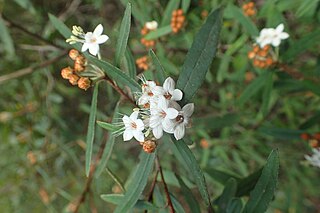
Phebalium woombye, commonly known as wallum phebalium, is a species of shrub that is endemic to eastern Australia. It has branchlets covered with scales and star-shaped hairs, elliptical leaves, and white to pink flowers arranged in umbels of four to ten flowers.

Asterolasia buckinghamii is a species of slender, erect shrub in the family Rutaceae and is endemic to eastern New South Wales. It has star-shaped hairs on its young branches, broadly egg-shaped, hairy leaves and yellow flowers with rust-coloured, star-shaped hairs on the back of the petals.
Asterolasia buxifolia is a species of spindly shrub in the family Rutaceae and is endemic to a restricted area of eastern New South Wales. It has star-shaped hairs on its stems, leathery leaves and yellow flowers arranged singly in leaf axils with star-shaped hairs on the back of the petals.

Asterolasia correifolia is a species of erect shrub that is endemic to eastern Australia. It has white to brown star-shaped hairs on its stems, lance-shaped to elliptical leaves densely covered with white star-shaped hairs on the lower surface, and white to cream-coloured or yellow flowers arranged in umbels of four to ten or more in leaf axils, the back of the petals densely covered with white hairs.

Asterolasia drummondii, commonly known as Gairdner Range starbush, is a species of small shrub that is endemic to a restricted area of the southwest of Western Australia. It has egg-shaped leaves and white flowers arranged in umbels of five to ten flowers with rust-coloured, star-shaped hairs on the back of the petals.

Asterolasia nivea, commonly known as Bindoon starbush, is a species of weak sub-shrub that is endemic to the southwest of Western Australia. It has leathery oblong to narrow elliptical leaves and white flowers arranged in groups of about three flowers with thick-centred, shield like, star-shaped hairs on the back of the petals.

Asterolasia pallida is a species of woody, perennial herb that is endemic to the southwest of Western Australia. It has elliptical leaves and white flowers arranged in umbels of three to six with star-shaped hairs on the back of the petals and fifteen to twenty-five stamens.
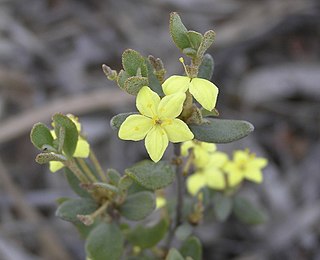
Asterolasia squamuligera, commonly known as yellow starbush, is a species of erect, woody, slender perennial shrub that is endemic to the southwest of Western Australia. It has leathery, egg-shaped leaves with the narrower end towards the base and yellow flowers arranged in umbels of five to ten with a fringe of scales on the back of the petals, and about ten stamens.
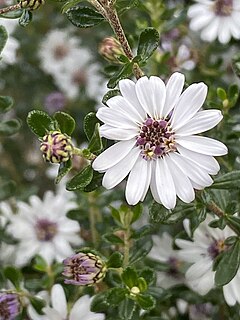
Olearia minor, is a small flowering shrub in the family Asteraceae. It has alternate leaves and white to pale mauve daisy-like flowers from winter to December. It grows in Western Australia, South Australia, New South Wales, and Victoria.
Diplolaena drummondii is an endemic Australian flowering plant in the family Rutaceae. It is only found in Western Australia. It is a small, spreading shrub with oblong to elliptic papery, thin leaves, and yellow, orange or reddish flowers which bloom between July and November.

















